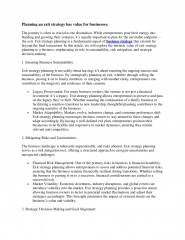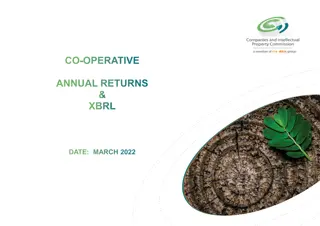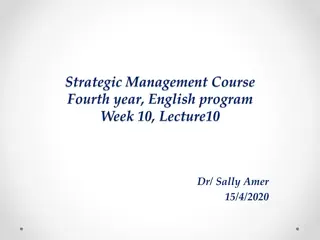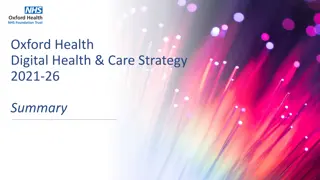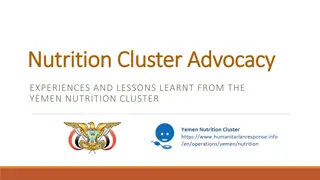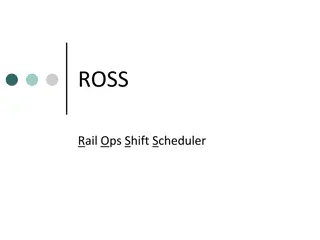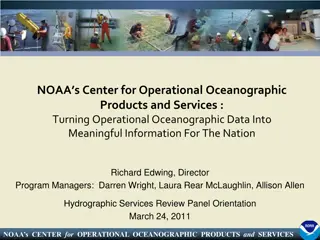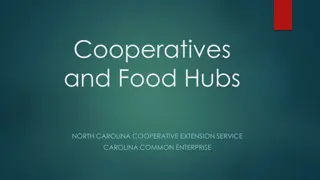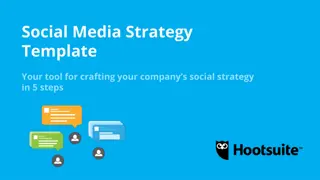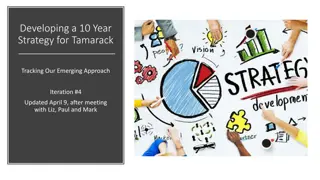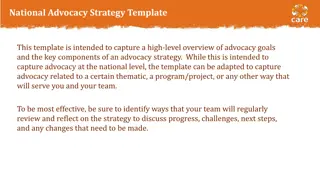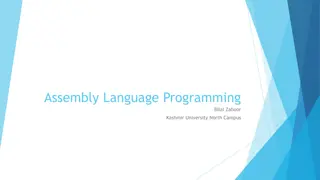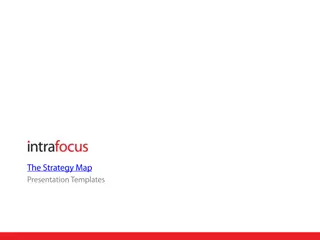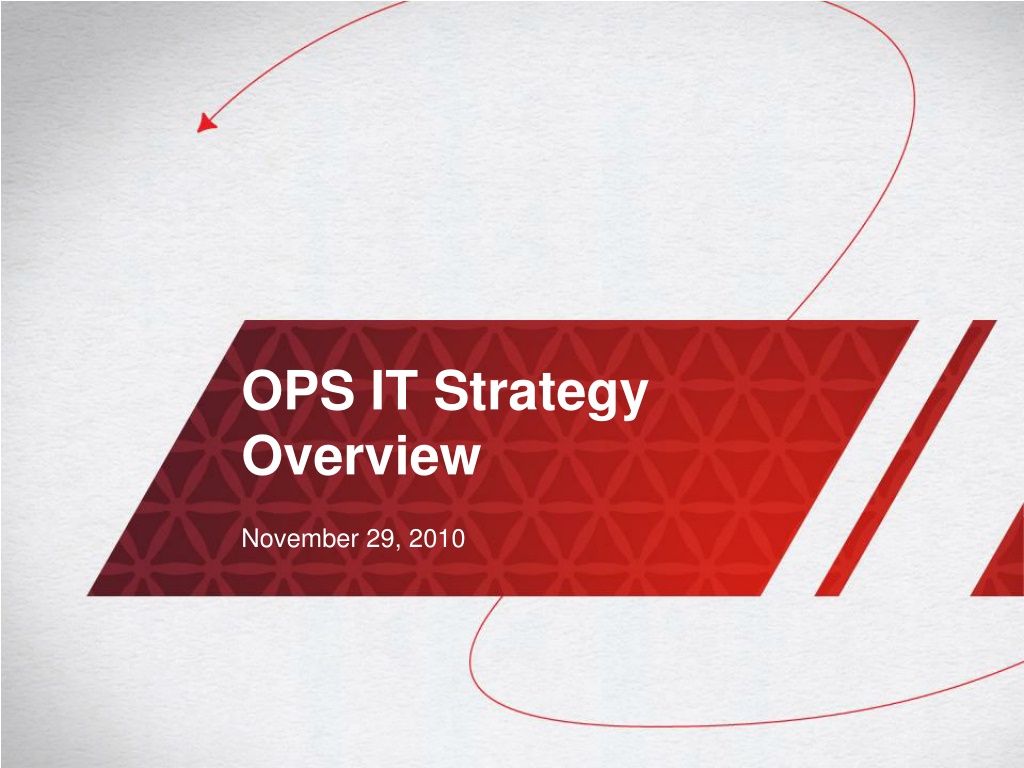
Enterprise Operations IT Strategy Overview
"Explore the comprehensive Ops IT strategy from November 29, 2010, focusing on improving product quality, supply chain performance, scaling operations, and creating a top workplace. Discover current challenges and future process assessments within enterprise supply chain processes."
Download Presentation

Please find below an Image/Link to download the presentation.
The content on the website is provided AS IS for your information and personal use only. It may not be sold, licensed, or shared on other websites without obtaining consent from the author. If you encounter any issues during the download, it is possible that the publisher has removed the file from their server.
You are allowed to download the files provided on this website for personal or commercial use, subject to the condition that they are used lawfully. All files are the property of their respective owners.
The content on the website is provided AS IS for your information and personal use only. It may not be sold, licensed, or shared on other websites without obtaining consent from the author.
E N D
Presentation Transcript
OPS IT Strategy Overview November 29, 2010
Operations Core Initiatives 2011 Improve Product Quality and Reliability Provide Effective Support to the WW Sales Teams, LOB s, Channel Partners and End User Drive Supply Chain Performance Improvements Drive Initiatives that will enable Operations to Scale effectively Establish Polycom as a best place to work OPS IT Strategy Summary 11-29-10 2
Current State We have an opportunity to leverage PS9 now that the technical upgrade is behind us. Currently, many manual processes exist that need to be automated to gain efficiencies. Primary issues include: Quote to order (too many manual checks and rework) e.g. pricing, contract management, NST processing, compliance checking Lack of Available to Promise capability Lack of Supply Chain Planning capability Business Processes need reengineering in order to support scaling the company to $2+B. Primary areas of concern are: Lack of a comprehensive E-Business strategy/plan for the company Lack of Sales/Demand forecast - S&OP planning process OPS IT Strategy Summary 11-29-10 3
Enterprise Processes Supply Chain - Enterprise Planning & Execution Development Product/Process E-Business Sales & Marketing Warehouse Management Product Development Shop Floor & Quality Cntrl Customer Supply Chain - Customer/Reps. Pricing/ Contract Management Transportation Mgmt/ Compliance Material Requirements Planning Inventory Management Order Demand/ Supply Plan Forecasting Purchasing Management Systems fully supports Systems partially support Known problem area for Systems Outsourced Financial Mgmt Financial Management Info Payroll & HR Accounts Payable Billing Administration & HR Accounts Receivable General Ledger Supplier E-Business OPS IT Strategy Summary 11-29-10 4
Process Assessment Summary CURRENT STATE STATUS FUTURE STATE NEED BUSINESS IMPACT Order Process/Ebusiness/Pricing 2 4 High Order Fulfillment/Quality 2 4 High 2 3 High Demand Planning Supply Planning 2 2 Medium 3 3 Low Procurement Compliance 2 3 High Key: 4 = Best Practice 3 = Highly Competitive 2 = Competitive 1 = Non-competitive OPS IT Strategy Summary 11-29-10 5
Process Importance OPS 2011 Objectives Legend H M L 5) Best Place to Work High investment impact = 9 Medium investment impact = 5 Low investment impact = 1 2) Effective Support to Customers & Partners 1) Improve Product Quality & Reliability 4) Enable Ops to Impact Summary 3) Supply Chain improvements Scale OPS Major Processes 33 29 L H H H M Order Process/E-business/Pricing Order Fulfillment/Quality 1 M M H H L 29 L L H H H Demand Planning 25 L H M H L Supply Planning Procurement Compliance 17 21 L L M H M M M M L L OPS IT Strategy Summary 11-29-10 6
Situation Analysis Order Processing/E- Business/Pricing Issues Actions No Business Sponsor & Scattered IT Resources Current capabilities (Transact) Online product orders (w. bundled service) with PO or CC EDI product orders Lack of business requirements to support SMB and SP Manual hand offs of orders and NST pricing Out of scope (not addressed in current investment proposal) Quoting, configuring, ATP/CTP, Bill Presentment, Landed Cost, Combined Product & Service Orders, Global Fulfillment, EDI Invoice, EDI Payment, Integration with provisioning, etc Appoint a small dedicated exploratory Team & Engage with the LOBs Assign Business Champion & Form Exec Steering Committee Clear IT Ownership established Support EPM and NST Automation/Touchless Order Processing Extend EDI capability to: Service ONLY Orders (Includes New & Renewals) Rain Maker Service Renewal Orders Automated Contract Creation and entitlement Extend Online capability to: Online new service orders (no renewals) Enhance EDI for change orders, catalog, etc. OPS IT Strategy Summary 11-29-10 7
Situation Analysis Fulfillment/Quality Issues Actions Challenged by end of quarter volume (lack of linearity) Need additional efficiencies to scale Business is becoming more complex e.g. global fulfillment LOBs demand new processes Enhance FDM: Direct fulfillment extensions Direct fulfillment for EMEA & Mexico Cross Dock (all regions) Merge in-transit at cross dock OPS IT Strategy Summary 11-29-10 8
Situation Analysis Demand Planning Issues Actions SFDC is being used to track opportunities, but not at a SKU level The Sales forecasting process has not been designed to support supply based planning We do not require certain information (like quantities and product line) to be captured as the opportunity moves along in the sales funnel We do not measure and report on the accuracy of forecasts/ opportunities Revise the sales forecasting process to capture data needed by Operations (document definitions and monitor progress) Adopt best practices of opportunity management/sales forecasting for multi-channel distribution Research options to enhance SFDC to assist in forecasting Research demand planning tools once the process is defined and working OPS IT Strategy Summary 11-29-10 9
Situation Analysis Supply Planning Issues Actions Sales forecasts/demand plans do not exist at a level that Ops can work with for Supply Planning purposes Ops lacks Supply Planning tools Ops relies heavily on spreadsheets to communicate build plan requirements to Celestica and other manufacturing partners Revise the sales forecasting process to capture data needed by Operations Develop a S&OP process to leverage into a demand plan Research supply planning tools once the demand planning process is defined and working FDM Enhancements: Supply demand match (Shortage workbench and pegging) Item Setup workflow Standard inventory replenishment Use of incoming inspection OPS IT Strategy Summary 11-29-10 10
Situation Analysis - Procurement Issues Actions Need to increase efficiency to scale Enhance FDM: Workflow re-design Deploy Requisition Globally OPS IT Strategy Summary 11-29-10 11
Situation Analysis - Compliance Issues Actions Business complexity is creating higher risks LOBs will drive a different mix of end user accounts (SMB customers) creating a need for more due diligence Need to be able to scale the business by automating manual tasks Enhance FDM: Workflow to assure product reference data is created Globally compliant commercial invoice Packing sessions/standards based shipping labels Holds management (multiple) Request date (multiple) OPS IT Strategy Summary 11-29-10 12
OPS IT Investments - 2011 Sales Forecast and S & OP Planning Process (Business design) 1 PM and 1 BA for 6 months = $150K E-Business Corporate Strategy Formation 1 PM and Booze Allen Consulting Work for 60 days = $100K FDM Internal Staff (supplemented with consultants as necessary): Order Automation/Touchless Orders Fulfillment Methods Compliance Automation (several enhancements) Contracts Database Procurement (Workflow/Reqs.) Planning (Supply-Demand Match Workbench/Pegging) OPS IT Strategy Summary 11-29-10 13
Order Fulfillment Projects and Initiatives for Efficiency OPS IT Strategy Summary 11-29-10 14
2011 Approach (OPS and PGS) OPS Key = PGS Month 9 Month 10 Month 11 Month 12 Month 1 Month 2 Month 3 Month 4 Month 5 Month 6 Month 7 Month 8 Compliance Automation Procurement Workflow & Reqs Enhance Supply-Demand Match (Shortage Workbench & Order Pegging) Available to promise Adoption & Stabilization Phase 1 Forecasting Process Design Implement Sales Forecast Fulfillment Capabilities (Cross dock, Merge & Collaboration) Service Spares Planning and Demand Forecasting for Spares Advanced Operations Order Promising and Planning Analytics Selection Process Professional Services Automation Supply Chain Planning RFP Phase 3 Siebel 8.1 Upgrade Knowledge Base BCG 13 Service Safety Stock Optimization and Planning Analytics BCG 14 Support BI Analysis & Scorecards Order Automation Touchless Orders & Fulfillment Standards Contracts Database Phase 2 Corporate E-Business Strategy Service EDI Order Processing Support Portal Enhancements OPS IT Strategy Summary 11-29-10 15
Dependencies EPM (Factor in Operations Execution requirements) CDI (Factor in Operations Execution requirements) Salesforce.com enhancements e.g. SKU level planning, NST automation Sales participation in the Forecasting/Demand Planning business process work Executive Sponsorship of E-Business Plan OPS IT Strategy Summary 11-29-10 16
PGS Situation Analysis Issues Actions Peoplesoft was not configured to handle a complex service logistics business many manual workarounds exist to run the business PGS does all of its supply chain planning outside of FDM The current webstore does not handle stand alone service orders or renewals Siebel PM module is no longer supported Pro Services growth plan requires a replacement Transaction processing with outside vendors does not meet business requirements Support portal requires additional features to support SMB customers We could prevent RMAs with a better knowledge base for partners and internal Tech Support Need BI to help with quality improvement Implement new functionality available in FDM to support services business model Implement a SaaS model for spares/repair planning Build EDI capability to handle service orders and renewals Turn on PS9 Project Accounting & integrate with Microsoft Project Server Fix XML transaction processing Add My Account feature on the support portal Upgrade Siebel to better support the knowledge base integration BI Repairs Scorecard and quality analysis OPS IT Strategy Summary 11-29-10 18
Strategic PGS IT Focus Areas Initiative Benefits CSAT & LOS Inventory Cost Audit concern #1: Improve PGS Supply Chain Performance Product quality Cost CSAT BCG # 13 # 2: Improve service request data collection and knowledge base integration Improved staff utilization Profitability # 3: Implement best-in class professional services management environment Cost reduction Order to cash cycle time improvement Audit concern # 4: Create an integrated eBusiness environment for services and products Cost reduction CSAT # 5: Extend support.polycom to support end-customers and LoBs Product quality Services profitability BCG #14 # 6: Improve PGS Business Intelligence and align with Corporate Data Warehouse OPS IT Strategy Summary 11-29-10 19
PGS IT Project Impact Matrix 5 Pillars PGS Goals GM LOB Prod MgmtMicrosoft Quality B2B/Cloud Growth/ Consol LOS CSAT Pro Svcs Growth OPEX Inventory Expansion #1 SC Planning & Forecasting M L L L L H H H L H H #1 XML/EDI cleanup & expansion L L L L L H H H L M H #1 BU/Location Alignment & deployment of FDM capabilities Siebel knowledge base integration Siebel Context-Driven Data Collection (Task UI) Best in class PM/PSA Environment Integrated eCommerce for products and services Extend support.polycom to support end-customers and LoBs L L L L L H H H L M H #2 M H M H L M H M M M L #2 M H M H L M M M L L L #3 M L H L L M L H H L L #4 H L H L H H M H L H L #5 H L M L H M H M L M L #6 PGS Business Intelligence M H M H L H M M M L H OPS IT Strategy Summary 11-29-10 20
eBusiness Phase I High Volume EDI Scope: Automate 60% - 70% of the 40,000+ service orders handled manually today (91% of orders for less than $5k) Extend EDI capability to support service orders (new & renewal) and RainMaker Cost: $451K Project duration: 6 months (IT development) ROI: Within 12 months of go-live Annualized cost savings of up to $1.088M (2013) Acceleration option Dedicated EDI deployment project manager to on-board partners Acceleration cost (2011): $100K Impact: ROI within 9-12 months; full impact by end of 2012 OPS IT Strategy Summary 11-29-10 21
Service Parts Planning Scope: Demand Planning, Supply Planning, Inventory Planning for Service Parts Business Support rapidly growing number of Advanced Depots and diversified service offerings Achieve 97% LOS without explosive growth of spare parts inventory and/or planning staff Cost: One-time implementation cost: $395K Annual SaaS fees: $230K ROI: Within 12 months of go-live Annualized cost savings of $1.2M (2013) due to head count avoidance, repair cost reduction and reduction of new buys OPS IT Strategy Summary 11-29-10 22
Professional Services Automation Scope Management of cost, schedules, resources and profitability for the Professional Services Business Reporting on backlog, revenue, profitability and resource utilization Cost Implementation and license cost: $509K ROI (based on best practice results driven by PSA implementation) Increase resource utilization by 8% Reduce revenue leakage by 2% Improve project margin by 10% OPS IT Strategy Summary 11-29-10 23
Support.xyz Scope Support LoB Strategy My Account for End Customers and Tier 2 Partners Localization to support APAC Integration with Social Media and support for Rich Media Partner tools and integration (eBonding) Cost: $331K (Capital & OpEx) Business Driver CSAT & LoB strategic support OPS IT Strategy Summary 11-29-10 24
BCG #13 Knowledge Management Quality Initiative Scope (PGS IT sub-scope) Siebel 8.1 Upgrade to support task-based UI and allow for better data collection in support of quality initiative Upgrade support.polycom to support task-based UI and quality- driven data collection Integration of JIRA into knowledge base search Translation of key knowledge base entries into Japanese, Korean and Simplified Chinese Cost (PGS IT sub-scope): $327K ROI (of the overall BCG #13 Initiative) $1.288M $2.676M (Year 4) OPS IT Strategy Summary 11-29-10 25
BCG # 14 - Quality Incentives and Monitoring for Repair Vendors Scope (PGS IT sub-scope) : Provides quantitative insight into failures, capturing serialized failure information, and implementing data driven quality / cost / delivery improvements. Cost (PGS IT sub-scope) $245K ROI (of the overall BCG #14 Initiative) $5.9M (Year 4) OPS IT Strategy Summary 11-29-10 26

